Recent Commercial Posts
Minimize Flooding Loss With Business Interruption Insurance
7/31/2022 (Permalink)
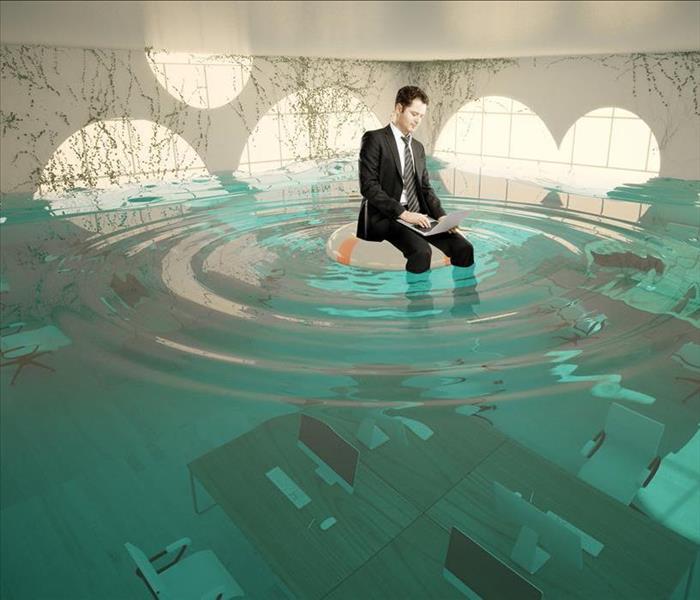 Minimize flooding loss.
Minimize flooding loss.
It takes a lot of work to run a business in Colorado Springs, CO. When the unexpected happens, such as flooding from a broken pipe, what will that interruption mean to your business? Business interruption insurance is supplemental coverage that helps a business weather the financial side of weathering the storm while a water damage and restoration company gets your business back to its preloss condition.
Minimize Losses and Prevent Downtime
Any unexpected downtime means financial losses on top of the costs associated with the repairs needed to fix large water damage. Additional insurance helps businesses stay afloat from financial losses.
Business Interruption Insurance
This type of insurance takes effect when physical damage to a property results in operations being suspended. Although coverage may differ across policies, it typically covers the following:
- Revenue that would have been made if the business was operating normally.
- Payments for loans, mortgages or leases during the downtime.
- Costs associated with temporary or permanent relocation.
- Provides money for employee payroll and taxes.
- Extra expenses incurred due to the event may also be covered.
Steps to Minimize Flooding Loss
While you may be able to count on the additional insurance coverage to keep your business from going under, prevention and planning for the worst are also key to minimizing losses. Every business should develop a business interruption plan. Key elements of this plan often include:
- Determining Risks: Identifying risks, both human and environmental, makes it easier to prepare for them. While some may not be preventable, such as a natural flood, knowing the risk is there enables creating an action plan to better handle the situation if it happens. Risks should be ranked according to severity and likelihood of happening.
- Know the Costs of Unexpected Downtime: Once the risks are known, each one should be analyzed and associated costs calculated. While making the calculations, include lost income, additional expenses, potential penalties or fines and the cost of delaying operations.
- Develop a Mitigation Plan: When developing a plan for controlling potential hazards, prevention, deterrence and mitigation are all essential. The first helps a business identify hazards that are preventable and take measures to avoid them. Deterrence focuses on the potential for criminal activities to happen and taking steps to minimize them. Mitigation focuses on events that are not preventable but require forethought to contain or control.
Establish a Communication Plan: When the unexpected happens, does everyone know what to do? A chain of command should be developed to ensure that vital information is shared properly. To eliminate confusion, develop prescripted messages that are clear and concise.
- Have an Emergency Plan: Along with an evacuation plan to ensure the safety of everyone, there should also be an emergency plan for the business itself. This may include ensuring that data is protected and easily recoverable, inventory essential to operations is well-documented and the business has written contracts with key vendors.
Flooding and other unexpected events can be devastating to a business. If faced with an unexpected shutdown, having business interruption insurance and planning for such events helps reduce associated costs and may keep the business from going under.
The Importance of Having a Security Fence
7/26/2022 (Permalink)
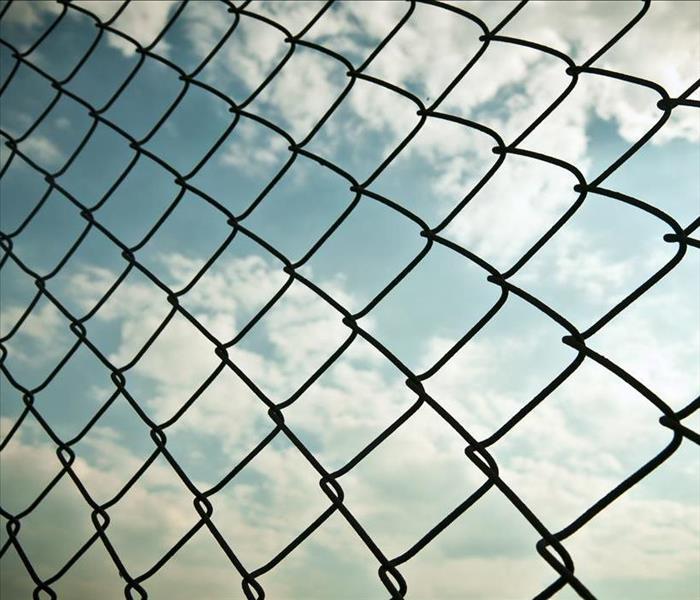 A security fence can further guard your property after suffering fire damage.
A security fence can further guard your property after suffering fire damage.
Fire can leave large, gaping holes in your commercial building in Colorado Springs, CO. You probably already know the importance of boarding up vulnerable places to protect what's left of the structure. Don't stop there, though. A security fence is necessary to further guard your property.
Reasons To Install a Security Fence After a Fire
You already have damage that happened during both the fire and the process of putting the flames out. If you don't take the proper security measures, though, you may soon be facing other problems:
- Vandalism
- Theft
- Animal infestation
- Safety issues
Having a fence around the perimeter of your property makes a clear statement about its boundaries. It may not guarantee all will be well, but it greatly increases your chances of avoiding unnecessary complications.
Deter Invasion
Most people see plywood across the busted windows of a building and take that as a sign to steer clear of it. Some see it as an opportunity, though. A security fence gives thieves, vandals and others with nefarious intent an extra obstacle to overcome. It makes your vulnerable building harder to access and thus less attractive to those looking for an easy mark.
While a fence may not keep out smaller vermin, it can provide an extra deterrent for some wildlife. In combination with boards and tarps that cover the holes in your building, it provides another layer of protection. The more barriers you set up, the more secure your building is likely to be.
Mark Boundaries
A damaged building often gives the impression of being abandoned if it stands alone. People visiting nearby businesses may think it's OK to park on the grounds of your property if it looks like no one else is using the space anyway. Another perk of having a fence is that it marks the space as off-limits to anyone who doesn't have your permission to be there. It saves you the time and energy of having to engage in the countless interactions it would take to set boundaries on an individual basis.
Provide Safety Cues
Curiosity is a natural response to a damaged building. Those walking by may wonder what happened and want to check it out for themselves. This safety hazard can have not only unpleasant consequences for those who venture into the building but also for you as the owner. Fire damage restoration experts recommend protecting yourself and others by installing a fence around the property.
Appease Insurance Provider
Making your building secure is a key responsibility all the time. It becomes especially important when the building is damaged. Your commercial fire insurance provider expects you to protect your building even when it's not in use, and the company is unlikely to approve a claim for damage that happens as a result of poor security, even if it occurs after a covered peril. Using a fence to clearly mark and protect your property proves that you are doing everything in your power to keep it safe.
A security fence does more than just give you peace of mind. It can protect your already vulnerable building from further damage after a fire.
4 Reasons IICRC Certification Is So Valuable
5/23/2022 (Permalink)
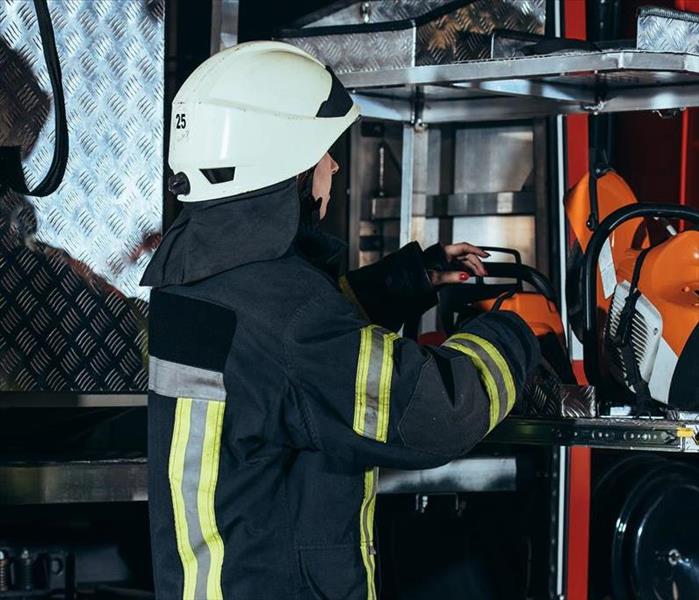 You can Trust in IICRC Certification. You can Trust us.
You can Trust in IICRC Certification. You can Trust us.
When companies in the restoration industry want a stamp of respectability, they often go to the Institute of Inspection Cleaning and Restoration Certification. The IICRC is a worldwide non-nonprofit organization that has been around since 1972. The organization provides 26 valuable professional certifications as well as additional standards in inspection, cleaning, and restoration fields.
SERVPRO has long understood the value of certifications in making sure its employees have the latest knowledge about cleaning practices for fire, water and mold remediation. A local restoration services franchise in Colorado Springs, CO, plays an active role in supporting the standards that continue to build on best practices for safety and efficiency in all areas of restoration. Professional certifications provide many areas of value for companies and customers.
Why IICRC Certification Is So Valuable?
1. The IICRC Provides a Broad Spectrum of Knowledge
Professional cleanup and restoration require specialized knowledge in many areas. Professional certification verifies that a technician has acquired an advanced level of knowledge in his or her field. This allows commercial customers to have a high degree of confidence in the abilities of SERVPRO technicians. This education takes much of the guesswork out of the recovery process and allows for the application of the latest scientific principles. A mitigation certificate signifies that the job will be done correctly the first time and eliminate mistakes.
2. The Organization Knows a Lot About Cleaning
While much of general cleaning relies on more basic knowledge, specialized cleaning often requires additional education. A commercial carpet maintenance technician, for example, intimately knows the ins and outs of making sure commercial carpets get the best treatment, while a carpet cleaning technician knows to restore a carpet after water damage. Likewise, a floor care technician is educated in the intricacies and subtleties of caring for flooring in a variety of situations.
3. It Places an Emphasis on Inspections
Much of the work after a disaster involves closely looking at the damage that has occurred and what can be done to fix it. Trained technicians know how to look at a disaster area and analyze the potential solutions. In the case of certified wood and laminate flooring inspector, the technician will have specialized knowledge that can aid in the recovery process.
4. The Organization Understands Restoration Principles
The goal of all work by a SERVPRO franchise is to restore the building to its original condition before a fire or storm disaster happened. Each situation is different, but armed with the proper knowledge technicians can make the best judgments about what is realistically possible. For example, an odor control technician understands what steps must be taken to rid a building of persistent odors from smoke. They utilize specialized equipment that does more than masks odors but eliminates them once and for all.
An applied structural drying technician knows the best way to get the moisture out of materials after water damage. A company that does not possess this knowledge could result in a job that has less than stellar results.
The IICRC and SERVPRO work together to improve the quality of the cleaning and restoration industry. They both help companies recover from disasters.
What Can You Expect From the Commercial Fire Cleanup Process?
5/12/2022 (Permalink)
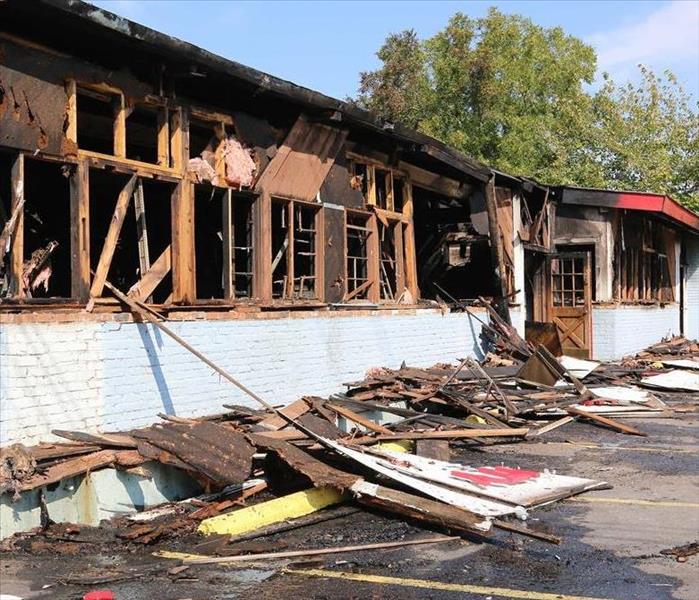 Know more about the Commercial Fire Cleanup Process
Know more about the Commercial Fire Cleanup Process
Confronting a fire at your commercial building in Colorado Springs, CO can be devastating. Even a small fire can cause enough loss to halt business for days or weeks. Whatever the severity, it's essential to take action immediately to reverse the fire and smoke damage, as well as the effects of the water and other extinguishing materials.
What Happens After the Flames Are Extinguished?
After firefighters extinguish the flames, it's time to call a fire damage restoration company as soon as possible. Immediately upon arrival on the scene, the technicians can begin mitigating the loss and restoring the damage. It's essential to start the process as quickly as possible, as the loss will only grow increasingly worse and spread with every minute that passes.
You can anticipate seeing the professionals complete the following steps.
1. Assess the Extent of the Damage
When the technicians first arrive, they will assess the extent of the damage. This assessment involves determining how far the damage has spread and the severity of the loss. The experts will inspect everything in the affected area, including the structure and contents. From these details, they will form the most appropriate plan of action.
2. Execute Emergency Mitigation Services
First and foremost, the experts will work to keep the deterioration from worsening. Standard mitigation services include extracting standing water with industrial pumps, boarding up broken windows and doors and tarping over holes in a roof.
3. Clean Up Fire, Smoke and Soot Damage
When the initial mitigation work is complete, the specialists will begin the cleanup process. After a fire, this process typically consists of removing charred materials and dust, as well as soot and smoke cleaning.
4. Remove Affected Materials and Excess Moisture
Anything affected by the fire, water or smoke damage must be removed for disposal or restoration. This comprises furniture, flooring and even drywall.
5. Conduct Restoration Services
The technicians will then begin restoring the structure and contents to return them to their pre-fire condition as much as possible. If needed, some items can be taken back to the restoration service's site for special handling. Other things will be removed and repaired or replaced.
The restoration process will include excess moisture removal with industrial fans and dehumidifiers. It will also consist of sanitization and deodorization.
6. Perform a Final Inspection
After the professionals complete the job, they will perform a final inspection. This check will ensure that everything has been completed thoroughly and that no other issues (e.g., mold growth or structural damage) are present.
Fires can be very harmful in several different ways, both directly and indirectly. Therefore, it's critical to mitigate the damage and restore the loss as quickly as possible. Knowing a little beforehand about the fire, soot and smoke damage cleanup process as part of your fire preparedness plan can be extremely helpful. Hopefully, you will never have to experience a blaze at your business.
However, you can prepare yourself by determining who you need to call and learning what to expect throughout the restoration journey in case a disaster does occur.
One Cleanup and Restoration Team Is Best for Full Fire Damage Recovery
4/13/2022 (Permalink)
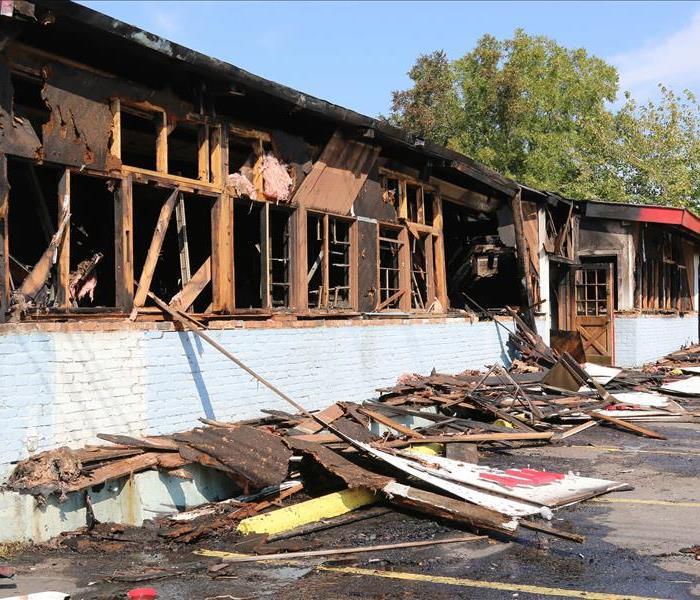 Have the Best Cleanup and Restoration Team and Enjoy A Full Fire Damage Recovery.
Have the Best Cleanup and Restoration Team and Enjoy A Full Fire Damage Recovery.
When your Colorado Springs, CO, property is affected by fire and soot, it's crucial that recovery and restoration work begin immediately to lessen the fire damage. Within a short period of time, the acidic qualities of soot and the penetrating qualities of smoke can leave permanent scarring. An experienced fire mitigation team quickly and thoroughly puts a stop to damage and completes the recovery process to get your company back into business.
Long-Term Fire Damage Begins With Initial Cleanup
One of the best reasons to work with fire cleanup and reconstruction experts for your full recovery is that lasting results begin as soon as the fire department leaves. The smoke and soot particles left in the air penetrate quickly into surfaces. Water from the fire department hoses is rapidly absorbed into carpeting, fabrics, wood, and structural elements. Technicians working toward full recovery perform many actions during their first trips to your property:
- Board up the building to prevent secondary damage and to improve security.
- Assess structural damage and stabilize the property as necessary.
- Determine what can be saved, cleaned, refurbished, and restored.
- Document damages for the insurance adjuster.
- Provide an estimate of the project, the costs, and the time frame.
- Discard unsalvageable items and store other belongings.
These initial steps provide an environment where the rest of the recovery process can be undertaken safely and efficiently.
Specialized Equipment Removes Smoke Damage
The main goal of the fire damage cleanup and recovery team is restoring your property and getting you back to work. Specialized scrubbers are used to eliminate smoke odors and soot stains. These tools are used on exterior and interior surfaces, including walls, ceilings, windows, patios, and sidewalks. Inside your building, cleansers and sanitizers are used to treat the same surfaces, as well as floors, the basement, and furnishings. Professional equipment, including ozone machines, are used to neutralize lingering particles and odors.
Water Damage Is Addressed Through Ventilation and Powerful Cleansers
Of course, there's a significant risk of water damage, so professionals must also get to work removing water from the building. This involves shutting off electricity, testing the integrity of structural elements, and monitoring levels of humidity. With high-powered fans and dehumidifiers, technicians dry the building and remove floating contaminants.
Progress Moves Forward Without Delays
When multiple recovery companies are hired to aid in the recovery of your property, there's a risk that mold growth will go unnoticed. Mold prevention begins with the tarping and boarding step, right after the fire department has left. This step continues as water-logged furnishings are removed from the building and as ventilation throughout the property is increased. During water extraction, further steps are taken to neutralize and remove any remaining mold particles.
A Speedy Recovery Matters
Recovering from fire damage doesn't have to take a long time. When you choose one experienced restoration team, each step is completed smoothly and without unnecessary delays. Each point of the process moves forward seamlessly. When a speedy recovery is essential to your company, contact a cleanup and restoration crew to see you through from beginning to end.
Prepartion Key to Weathering High Winds
3/9/2022 (Permalink)
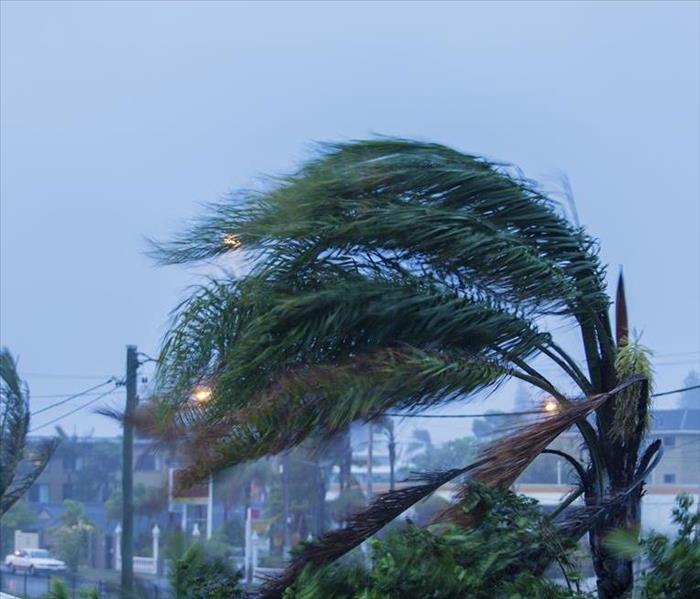 Follow These Key Tips and be ready for Storm and High Winds.
Follow These Key Tips and be ready for Storm and High Winds.
Business owners in Colorado Springs, CO, know what the aftermath of hurricane damage looks like. Although it may not be possible to avoid damage, being prepared before the storm hits is essential to protecting a business and its employees. That protection comes in the form of structural maintenance and a procedural plan to minimize downtime and keep employees safe.
5 Tips to Reinforce a Property
High winds may easily cause downed trees and power lines, as well as the potential for flying debris to break windows and cause other issues. Below are five ways to prepare the structure to better handle the storm.
Keep Trees Trimmed:
Falling branches are one of the most common causes of damage. Ensure that no branches are hanging over the roof or close enough to break a window. Any trees with hollows or other issues should be inspected by an arborist to ensure they are safe.
Choose Proper Landscaping:
Although rocks may add a pleasing aesthetic, they may become airborne during severe weather. There are many varieties of mulch that help spruce up the property while being less prone to causing damage.
Regularly Inspect the Roof:
This protective layer deals with a lot. Over time, a missing shingle or crack may easily become a big problem. To mitigate hurricane damage, have a professional roof inspector check it for any issues. That includes ensuring seals around vents or skylights are secure. As the owner, regularly complete a visual inspection for signs of trouble or debris on the roof.
Check Window and Door Seals and Hardware:
Any cracks or crevices give strong winds and rain an easy path to enter the business. Verify that all windows are sealed tightly and that door hardware is secure and braced to handle the weather.
Secure Outdoor Equipment, Structures:
Any additional structures or equipment on the property, such as a shed or dumpster, should be securely anchored. If the business has any vehicles, it is best to park them in a garage. If that is not possible, inspect the surroundings for potential items that could cause damage.
Have a Business Disaster Planin Place
Along with securing the property, how the business operates also needs to be secured. Creating a disaster plan is essential to minimize a business interruption, ensure employees and vendors know what to do, identify areas of potential risk, and protect assets. This plan should include a detailed outline of vital business operations, as well as procedures to follow during an unexpected event. A business should also keep data backed up at an off-site location or the cloud.
Delegate safety protocols to specific employees to help better ensure that things will run more smoothly during the chaos. Additionally, it is recommended to ensure there are extra supplies available during an emergency, such as batteries, first-aid kits, water and food.
While hurricane damage may be unavoidable, there are ways to secure your business to minimize the aftermath. Along with regular maintenance and staying on top of any repairs, have a detailed plan in place to handle the impending weather event.
The Sewer Damage Cleanup Process
2/18/2022 (Permalink)
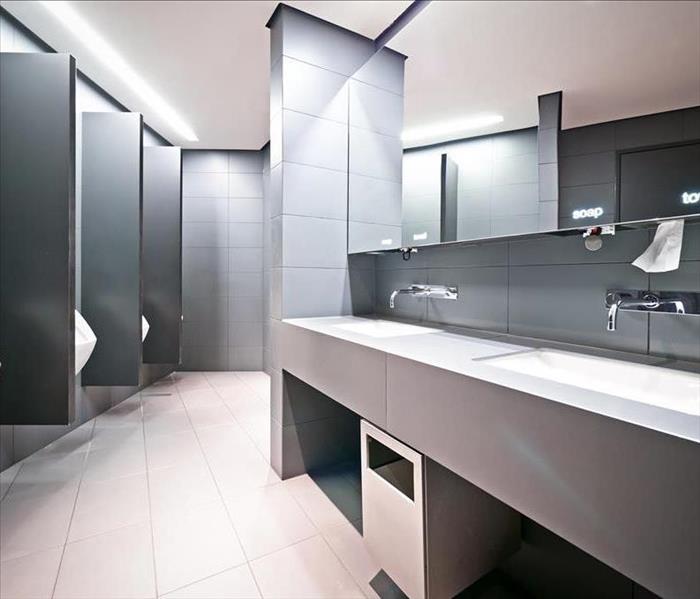 Follow these tips if you experience a Sewer Damage Cleanup Process in your Colorado Springs, CO, property.
Follow these tips if you experience a Sewer Damage Cleanup Process in your Colorado Springs, CO, property.
An overflowing toilet in the public restroom of your commercial building in Colorado Springs, CO, may not seem like that big a deal at first, especially if the mess is mopped up quickly. The staff who responds to the crisis initially, however, only sees what happens on the surface.
What to do if you Experience Sewer Damage?
An overflow is likely to cause sewer damage not only to the floorboards under the bathroom tile but also to the ceiling of the space directly beneath it. The cleanup process must be swift and thorough to prevent ongoing issues.
1. Assessment of Sewer Damage
The first thing you need to do is call a reliable sewage mitigation company. When the team arrives, the technicians assess the damage to the building and provide a report that contains valuable information:
- Extent of the damage
- Cleanup procedures recommended
- Estimated cost for restoration
The team leader can guide you through what the cleanup process will entail and give you a general timeline for when you can reasonably expect the sewage company to complete the repairs. Submit this report with your insurance claim to verify the work that is being done.
2. Removal of Water and Materials
Before technicians can clean the area, they must remove everything that doesn't belong in the space. If there is still standing water in the restroom, between the floors or leaking into the room below, it has to be pumped out. Then the team tears out all materials that show signs of sewer damage. This is likely to include flooring, ceiling tiles, insulation and drywall with which the contaminated water came into contact.
3. Disinfection of Affected Space
After all ruined materials have been removed, it's time to disinfect and deodorize the area. Sewage contains bacteria and other microbes that you certainly don't want to be left in your building. The mitigation crew uses industrial cleaners to sanitize the space. Technicians also may use an ozone machine or other treatments to remove any foul odors that linger.
4. Drying Area
It's not enough for the space around and underneath the flooded toilet to be clean; it must also be dry. This is one of the key steps for preventing secondary damage such as mold growth, which thrives in damp environments. Every remaining surface in the area must be dried. Technicians can also ensure that the humidity level is in an acceptable range so that moisture does not become an issue.
5. Rebuilding the Structure
The last step of the restoration process is replacing all the materials that were torn out. Technicians rebuild walls and add new ceiling tiles. They install new insulation and flooring and make sure that it matches the remaining structure. When it is finished, you shouldn't be able to tell where the old tiles end and the new ones begin.
When there is a problem with your building stemming from an overflow on an upper level, the floors beneath it are also in danger of sustaining sewer damage. Call a remediation company so that you can get the cleanup process started as soon as possible. Fast action prevents further issues and gets your building back to normal in a timely manner.
How Business Insurance Coverage Works
1/14/2022 (Permalink)
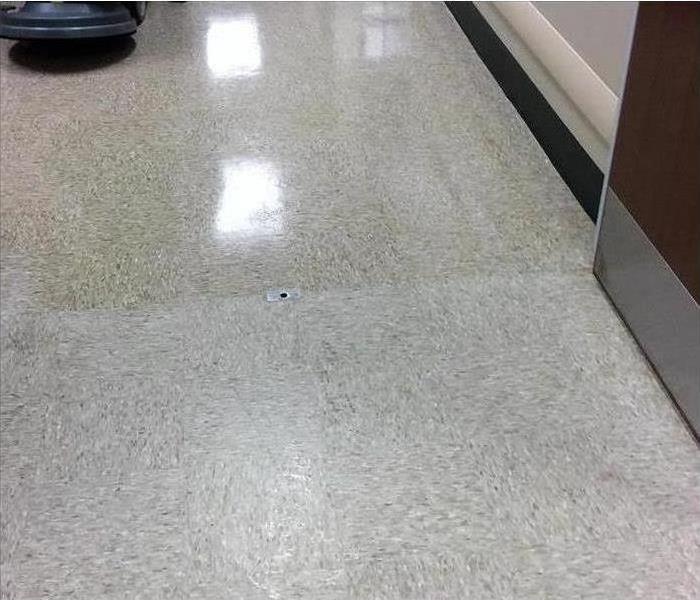 Water damage in a commercial building in Colorado Springs, CO.
Water damage in a commercial building in Colorado Springs, CO.
Your business in Colorado Springs, CO, needs protection from a variety of potential problems. Basic property insurance is a must, but you also may benefit from flood or storm insurance. While your insurance agent is able to advise you on the policies that you should include in your commercial package, it doesn't hurt to have an overview of the information before you meet with him or her.
Types of Coverage
It takes a village of policies to cover a commercial property adequately. There are several types of insurance coverage to think about:
- Property insurance – covers general repairs, such as water damage from leaks, caused by accidents or external factors
- Flood insurance – covers more extensive damage caused by prolonged rainfall, overflowing rivers and streams, and breaking dams or levees.
- Storm insurance – covers damage from wind, hail, or other elements of the specific storms listed in the policy
You may also consider a business continuity policy so that you have the working capital to stay afloat while storm remediation experts are working to return your building to an inhabitable space.
Dollar vs. Percentage
Insurance policies can have different types of deductibles. Many plans have dollar deductibles. A specific amount stated in the policy must be paid before insurance kicks in. These deductibles are often determined by the standard rate for the area, and raising the amount may result in lower premiums for the policy. A percentage deductible is sometimes used in storm and flood policies to lower the risk for the insurance company. Because the damage covered by these policies tends to be large, so do the payouts. This deductible depends on a percentage of the property's overall value.
When shopping for commercial insurance coverage, a basic property policy isn't enough to cover everything that might come your way. It's a good idea to add additional policies, such as flood and storm insurance, so that you can be confident that you will be able to overcome any damage that happens to your property.
Business Interruption: Minimizing Flood Loss and Delays
1/13/2022 (Permalink)
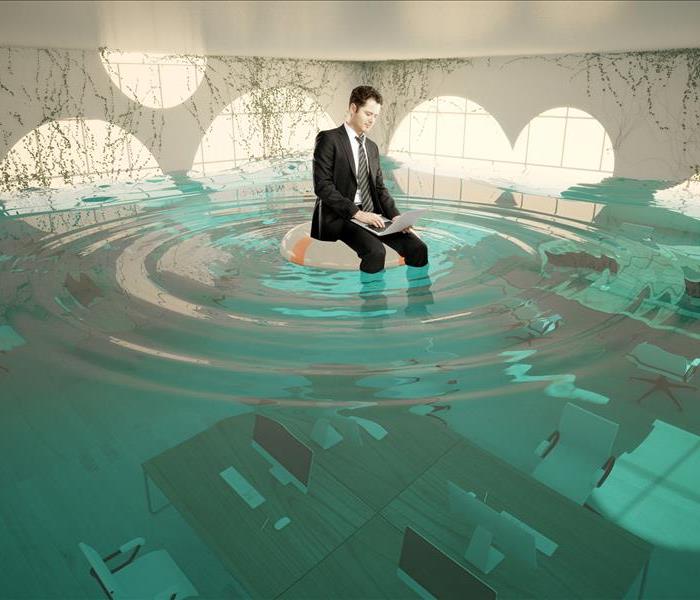 As an owner in Colorado Springs, CO, Minimize Flood Loss and Delays by following these important tips.
As an owner in Colorado Springs, CO, Minimize Flood Loss and Delays by following these important tips.
The last thing any business wants after experiencing flooding or any disaster is extensive business interruption. Business interruption accounts for any losses incurred as a company attempts to recover from the loss.
Important Tips to minimize Flood Loss and Delays
After a flood, a business might need to shut down all operations or move essential operations off-site. The closure and move might cost the company revenue. Business interruption insurance can help mitigate any financial losses, but coverage depends on the policy.
The goal to a quick recovery is to hire a restoration service in Colorado Springs, CO, especially a company with familiarity in water loss. These services can help in a few key areas, including:
- Loss mitigation
- Disaster Cleanup
- Property restoration
Flooding and Business Interruption
Many businesses, especially aging operations, can experience a broken pipe, leading to a flood. Depending on the hours of operation, a break can go unnoticed for several hours or several days, resulting in a significant accumulation of water.
The longer water is left to stand, the greater the opportunity for compounding problems. For instance, a flood can lead to mold development in as few as 48 hours.
Companies should have guards, cameras, or notification systems in place to reduce the risk of extensive flooding or unmonitored periods. However, beyond preventative measures, companies should also have a qualified mitigation service on standby for remediation and recovery.
Mitigation and Recovery
Extensive or large water damage is costly, and it is time-consuming to clean and repair. The standard restoration service has a three-pronged approach to the recovery process: mitigate, clean, and restore.
Mitigation involves stopping the flow of water and limiting or restricting the damage. It can include shutting off and repairing pipes or supply valves or using tarps and buckets to trap and catch water.
Cleaning is aimed at removing excess water and disinfecting the facility. Most restoration services will use various tools, including:
- Shop vacuums
- Fans
- Blowers
- Dehumidifiers
Finally, the service will focus on restoration, which means restoring the facility to pre-disaster conditions. As a business owner, you likely care about the timeline to recovery and restoration, but that will depend on the specific cause of your business's disaster.
Qualified Restoration Services
The key to working with a restoration professional is to only work with those who are qualified. A company should have a license and insurance. You should verify this information with the certifying bodies, ensuring you are working with a real and proven professional.
One credential to look for in any restoration service is the IICRC. Any company bearing those initials has proven its understanding of fundamental disaster response requirements. Insurance is also essential for any restoration service. Suppose the company working on your site does not have adequate or proper insurance. In that case, your business is potentially on the hook for any damages or injuries that occur on your property.
While no business owner wants to experience flooding, it can happen. The best any owner can do is limit their exposure and business interruption through planning and making necessary connections and arrangements with qualified restoration services. It is vital that you do not waste time after a flood. The sooner your property is restored, the sooner you can get back to business.
Don’t Be Sorry, Be Proactive about Preventative Business Measures
12/10/2021 (Permalink)
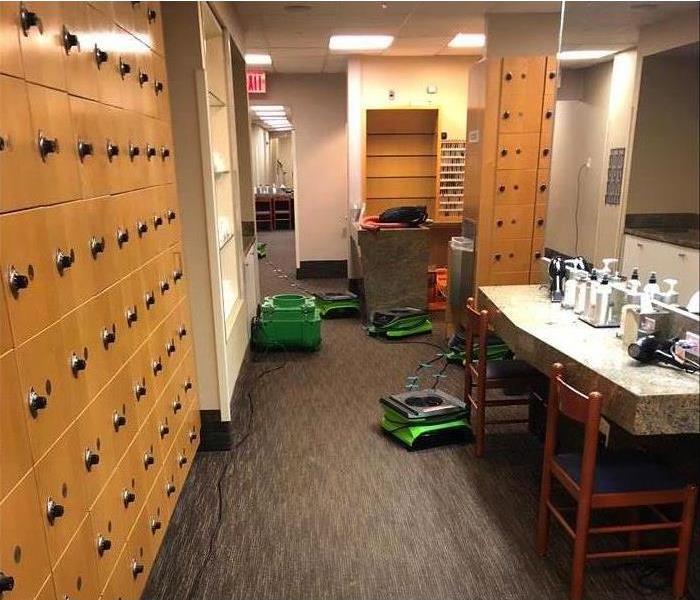 SERVPRO equipment drying out this commercial building.
SERVPRO equipment drying out this commercial building.
A pipe break can lead to water damage which ultimately leads to filing a business claim. The claim process can be extensive and can cause an interruption in the business for days or possibly weeks. Taking small steps now, however, can reduce the risk of having to file any water-related claim.
Steps to Avoid a Pipe Break
1. Insulate Exposed Pipes
Insulating any pipes that are exposed to frigid temperatures can reduce the risk of burst pipes. The insulation will prevent the buildup of ice inside the pipe; therefore, reducing the risk of increased pressure.
2. Maintain a Consistent Temperature
Allowing a building to go below 55°F consistently dramatically increases the risks of frozen pipes and pipe breaks as well as filing a business claim and should be avoided if possible.
3. Keep Drainage Areas Clear
Preventing minor flooding can be as easy as keeping drainage areas clear. This can be done by inspecting drains, downspouts, and gutters frequently to ensure that there are no blockages that would encourage backflow.
4. Remove Excess Snow
Another way of preventing minor flooding and even possible roof damage is to remove any excess snow. Snow not only increases the load on your roof but during the thaw it is possible that the melting snow will seep into minor imperfections and weaken the structure of the roof.
5. Fix Leaks and Cracks
It may also be a good idea to regularly walk the perimeter of your building, checking the foundation in the exterior for any cracks or leaks. Any minor imperfections can usually be corrected with exterior sealants; however, significant cracks may require the use of a restoration company in the Colorado Springs, CO, area.
6. Protect Valuable Items
While performing any of these preventative steps can reduce the risk of water damage, it may still be wise to protect any valuable items by keeping them above ground level and even in waterproof bins.
While a business claim is not necessarily a bad thing, it can take time to process, and that is valuable time that your business cannot afford to lose, which is why it’s better to be proactive rather than sorry.
Is Renter's Insurance Enough
6/22/2021 (Permalink)
 Flooding can cause damage to your property.
Flooding can cause damage to your property.
The main advantage of living in an apartment is you needn't concern yourself with the typical structural maintenance and repairs of homeowners. However, that doesn’t mean a renter is completely without concern or need of a robust renter's insurance policy or a storm mitigation specialist in Colorado Springs, CO.
Flooding, for example, is a complex issue involving structure and personal property. What happens in this situation? Are you or the landlord responsible, and if you are, will your standard insurance coverage be enough? There are a few things to understand in such complex situations.
Things to Know about Renter's Insurance
1. The Landlord is Only Responsible for the Structure of the Building
A landlord is not responsible for all contents inside of a building, typically. They are liable for any damage to the property and structure of the complex. The landlord must also maintain all essentials and ensure a safe and habitable environment.
However, while a landlord is not responsible for damages to personal property in most situations, they might be liable if they did not take adequate action. If a landlord, for example, waits several days to report the aftermath of a flood, resulting in more water damage and potential mold contamination, a tenant might have ground to sue.
2. Standard Renter’s Insurance Typically Does Not Cover Flood Loss
When reviewing potential renter’s insurance policies, be sure to read through the coverages thoroughly. Most basic policies, while affordable, do not cover flood damage. If you are interested in flood coverage, you will need to purchase supplemental coverage. However, make sure to read the exceptions in the supplemental policy to ensure it covers what you need or are concerned about.
3. Personal Property is Almost Always a Tenant Responsibility
When renting an apartment, you are entering an arrangement with the landlord. The agreement has risks for both parties. The landlord understands things might happen to the structure during your stay, and you understand things might happen to your belongings. Each party is responsible for their property usually.
The best defense against property loss is an adequate renter’s insurance policy. Make sure your policy covers anything you are worried about, and buy a supplemental policy for anything extra.
How To Clean Up Water Damage
5/25/2021 (Permalink)
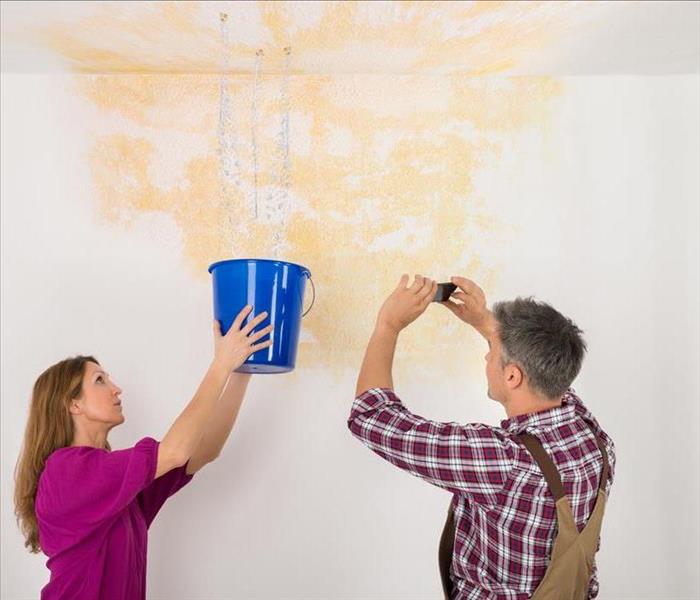 Dealing with water damage
Dealing with water damage
Water damage in your commercial building in Colorado Springs, CO, can come from a variety of sources. A toilet on the second floor can overflow and flood the room below it, or heavy rains can seep into the lower levels. While no amount of damage is good news, the best case scenario results from a clean water source. The cleanup process in these cases is fairly straightforward.
4 Steps of the Cleanup Process
Locate Source
Water restoration specialists assess the damage of your building when they arrive on site. One of the best indicators of how complicated the restoration process is going to be is the source of the excess water:
- Supply line leak
- Busted pipe
- Faulty equipment
- Toilet overflow
- Floodwater
When water is contaminated, the technicians know that strong disinfectants and extra equipment will likely be needed to fully mitigate the damage. If the damage comes from a clean source such as a broken pipe, however, they can focus their plan on simply replacing ruined materials.
Tear Out Damage
Even with a clean water source, some of the walls, insulation, flooring or ceiling tiles may be saturated. These ruined materials must be removed so that they don't develop secondary damage such as mold growth. Technicians will likely mark a flood cut several inches beyond the damage they can see to ensure that all the saturated spots are removed.
Dry Area
Even after all the waterlogged materials are gone, the team must make sure the remaining surfaces are dry. This protects the remaining portion of the building from further damage. It also prevents damage in the new parts of the structure.
Rebuild Space
Finally, the restoration specialists put up new walls, floors and ceilings to replace what was removed. They match wallpaper, paint and tile to the remaining structure. The final result is that no one can tell where the damage happened.
A clean water leak or spill may still cause a lot of damage. The cleanup process is relatively simple, though.
4 Tips for Preparing Your Business for Flood
4/15/2021 (Permalink)
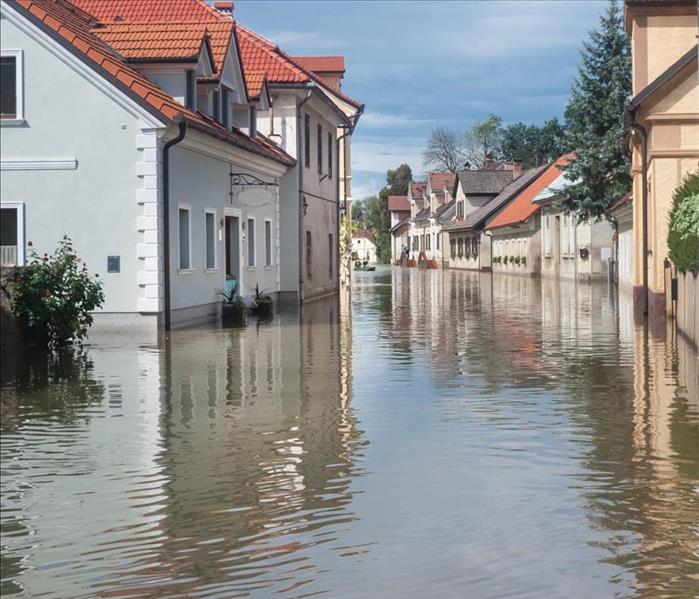 Prepare your building for flooding.
Prepare your building for flooding.
Floods can be and are often unpredictable. Heavy rains and overflowing bodies of water are just two common causes of flooding. Different areas of the country have different levels of flood risks. It's impossible to be totally prepared for every possibility, but there are measures you can take to make a significant difference in the event a disaster occurs.
4 Ways to Prepare Your Business for Flood
1. Create an Emergency Kit
Create an emergency kit with all the essentials stocked in case of a flood. It should include a well-supplied first aid kit, medicines, non-perishable food, a can opener, eating utensils, bottled water, flashlights, a battery-powered radio, spare batteries, blankets and any essential phone numbers.
2. Assess Your Insurance
Call your insurance agent to ensure you have enough of the correct insurance type to provide an adequate coverage amount for whatever might occur. See if you can add coverage for flooding, as well as business interruption coverage. This can cover you from property destruction, black water cleanup and sanitization, and lost revenue if the business has to shut down for a while. As water damage restoration professionals return the building to its preloss condition, you can continue to pay your employees.
3. Design an Emergency Evacuation Plan
Some roads will be blocked by high water or debris, such as downed tree limbs during a flood. Check with the Federal Emergency Management Agency for topography maps of your area. This provides a way to plan alternate routes for your employees to navigate home safely.
4. Backup Important Documents and Data
All of your important documents, whether digital or paper documents, must be backed up. These include insurance documents, employee files, vendor contact information, contracts, etc. You should save digital files to the cloud and make copies of paper documents to be kept off-site.
Whether your Colorado Springs, CO, building's location is particularly susceptible to flooding or not, you must be prepared for flood damage for your employees' safety and the preservation of your business.
The Basic Workings of Fire Sprinklers
3/26/2021 (Permalink)
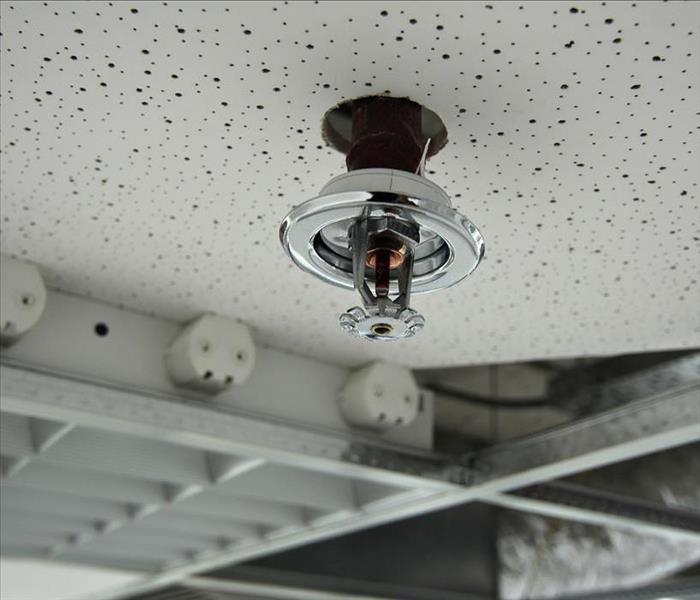 Fire Sprinklers are required
Fire Sprinklers are required
Fire sprinkler systems are required in commercial and residential buildings; you've probably noticed the sprinkler heads on the ceiling. They're invaluable fire suppression tools for protecting lives, structures and contents. Most people don't know exactly how fire sprinklers work, though.
Basics of Fire Sprinklers
Here are a few of the basics:
1. There Are Different Types of Sprinkler Pipe Systems
There are two main types of pipe systems. A wet pipe system keeps water pressurized in the pipes. The water is immediately released when a sprinkler head is activated. In a dry pipe system, pressurized air, not water, is collected in the pipes. Therefore, when a sprinkler head is activated, the air is released from the lines. This release of air allows the water to flow through the pipes.
2. Sprinklers Detect Heat, Not Smoke
Many people think smoke triggers fire sprinkler heads, but this isn't true. They are actually triggered by extreme heat. The fire heats the air above the flames quickly as the air flows across the ceiling. Fire sprinklers are typically designed to activate when the heat reaches 135 - 165 degrees.
3. Sprinkler Heads Activate Individually
Sprinkler heads activate individually, so only the ones in the fire's high temperature will activate (it could be one or multiple heads). They're designed this way to minimize water damage. Typically only one or two sprinklers are needed during a fire. This normally either stops the fire entirely or controls it until the fire department arrives.
4. Sprinklers Must Be Turned Off Manually
The sprinkler system has to be manually turned off at the main fire riser to stop the water flow. This riser is where the sprinkler system pipes connect to the building's main water supply. Water damage remediation professionals will be necessary to complete the fire sprinkler cleanup. Then, the activated sprinklers will have to be replaced.
The fire sprinkler system in your Colorado Springs, CO, building could make the difference between saving the building and its contents or sustaining a total loss. Now you know a little more about how these systems work.
3 Mitigation Tips for Commercial Water Damage Until Help Arrives
2/11/2021 (Permalink)
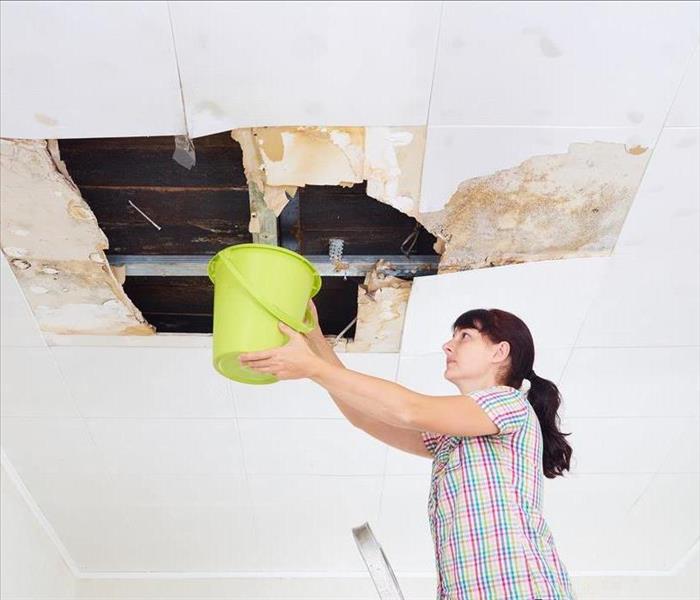 Bursting pipes can lead to severe damage.
Bursting pipes can lead to severe damage.
After a pipe burst or a sewer backs up into your facility, the aftermath can feel overwhelming. Many business owners do not know how to deal with the aftermath of a water disaster, which is why they typically have a disaster restoration service in Colorado Springs, CO, on standby. However, to help you through until such services arrive, consider the following three damage tips.
3 Damage Tips for Commercial Water Damage
1. Shut Off Water Source
Before considering any cleaning tips, you should think about the source of the water. With pipe breaks or leaks, find the nearest water supply shutoff valve and seal the line. Turning off the valve should stop any more damage from happening, but if the closest valve does not seem to work, consider shutting off the main valve. Keep in mind the water supply in the line will still trickle out even after closing the valve.
2. Document the Scene
If it is safe to enter the facility, consider documenting the scene. Out of all the damage tips, documentation is key to filing insurance claims. You will often need to provide proof of loss to insurance adjusters, but it can take time for these adjusters to come to your property, meaning pictures and receipts of damage can sometimes be sufficient and helpful.
3. Begin Removing Excess Water
If there are no evident safety risks, you can begin removing excess water or drying the floors. However, if water levels are above electrical outlets, it is best to wait for disaster professionals. Keep in mind that the absence of light does not mean the absence of electricity.
The above damage tips are not meant as a complete mitigation strategy for businesses. The three suggestions above are only offered as suggestions to productively pass the time until a professional service arrives. Stopping water flow, documenting the damage, and removing excess water are all essential activities that can help move the restoration and claims process along.
3 Options for Cleaning Fire Damaged Contents
1/20/2021 (Permalink)
 Consider professional content cleaning services.
Consider professional content cleaning services.
If you have had a fire in your building, you may think the only solution for dealing with your fire damaged contents is to throw them out and buy replacements. However, cleaning methods, such as dry-cleaning, can be used to restore some contents that might otherwise need replacement. These are three of the options you have for dealing with fire damaged contents.
Three Options For Dealing With Fire Damaged Contents
1. Move-Outs/Pack-Outs
If your building has extensive fire damage, you may need to move all of your contents out of the building to facilitate restoration and repair. A fire restoration company in Colorado Springs, CO, can efficiently move your contents out of your building, organize them and provide content storage until you are ready to move them back in.
2. Professional Cleaning
Some types of contents may be easily cleaned by wiping them down with soap and water, but other items may need the services of a professional cleaning company to be properly restored. Dry-cleaning is performed to remove light residues or pre-clean items before wet cleaning. Wet cleaning can be effective for removing moderate to heavy residues. Items that can't be wet cleaned may be cleaned by spraying and wiping. Foam cleaning is used for upholstery fabrics.
3. Document and Photograph Drying
If you have valuable documents or photographs that were damaged by water or fire, they may be able to be restored through professional content cleaning. The cleaning methods used depend on the type of documents and the amount of damage and include air drying, freeze-drying, dehumidification, vacuum thermal drying and vacuum freeze-drying.
Before you start throwing out your fire damaged contents, consult with a professional cleaning service in Colorado Springs, CO. Using dry-cleaning or other methods to clean your damaged property can preserve difficult to replace items and save you money by restoring items that may otherwise need to be replaced. Check with your insurance company, before you make your final decision.




 24/7 Emergency Service
24/7 Emergency Service















